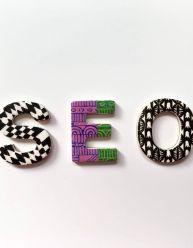What is SEO?
(and why you shouldn’t ignore it).
I was recently in a networking meeting with fellow businesswomen, and I asked my peers if they had any questions about websites. Someone said, “What is SEO?” Immediately everyone around the table started nodding their heads, agreeing, and adding things like, “Yeah, I always hear people talking about it but have no idea what it means,” and “I have no idea what it is and why it’s important.”
So that’s what this blog is for … to answer a few of your top concerns:
- What is SEO?
- Why is SEO important?
- And little things you can do to improve your SEO
(or get your website person to do for you if you have one)
What is SEO?
SEO is an acronym and stands for Search Engine Optimization. So what does that mean in simple English for us non-techies?
It means doing certain things to your website to improve its interactions with search engines (like Google). When you have good SEO, your website shows up more frequently on Google and in people’s search results. By adding certain features and setting up things in a certain way on your website, a search engine is better able to understand what you do, and what you’re selling, and connect you with the right people searching for all of the same things.
Does that make sense?
Why is SEO important?
So now that we have answered ‘What is SEO?’ let’s talk about why SEO is important. SEO is incredibly important because if you ignore it and don’t do any SEO on your website then these things will happen:
- Search engines, like Google, can’t find you
- Search engines have no idea what you sell or what industry you are in
- Search engines can’t connect you with the people who want/need what you are offering
- You will not be on the first, second or even third page of search results
- Your site may even be penalized because it’s scoring badly on certain metrics
You might be thinking: “I’m a small business owner and don’t make big sales, so SEO is not as important for me.” But it is! You have worked so hard to create a website. You have put this awesome online resource out into the world, so why not make it the best it can be? It’s important to make sure that you’ve tricked out your website with at least some of the SEO musts and best practices. Keep reading to get a list of some easy next steps.
How to Improve the SEO On My Website?
I know that for a lot of us, the tech side of our business makes our eyes cross. It often feels a lot easier and attainable to put our heads in the sand and carry on just how we have been. Let me give you a few simple things that you can do to improve the SEO on your website:
- First off, if you have a ‘web person’ that handles your website and tech stuff. Book a call with them and ask them about SEO. Find out how/if your website has been optimized for it. If their eyes go glossy and they stare off into space – it might be time to call me so we can find you a new ‘website person.’ But you may be surprised that a lot of SEO has ALREADY been added to your site and you are in pretty good shape.
- Image Size – make sure that the images you have used on your website are under 1MB in size. I see this a lot, people are tweaking their site on their own or adding blogs with images and loading massive images (because how would they know any different?). Doing this drastically affects the loading speed of your site, the user experience and in turn how Google evaluates your site. (Try Tiny JPG – this site will shrink your images for you).
- Choose a keyword or phrase relevant to your business for each of your website pages. Make sure you mention it in your headline, subtitles, and throughout the page at least 3-5 times. This tells the search engines what each page is talking about. How do you figure out what keywords? Think about what you do. What your customers are looking for. What they might be typing into Google to find you. For example, for me it might be “marketing help in York Region” or “what is SEO?” (see how many times I used that term on this page 😉).
- Internal Links – a link is something you click on (a word, a button) that sends you to another web page. And INTERNAL LINK sends your visitor to another page on YOUR OWN website. Try to include an internal link on each page of your website. Example: To get more information, click the button below to visit our registration page. If you want to see internal links in action, click HERE to see a page on my website. See, how many times I gave the reader an option to click to another one of my pages.
- External Links – an external link is just like an internal link EXCEPT that instead of linking to one of your own website pages. It sends the reader to another website (not yours). Example: This project was in proud partnership with Business B (link to their site). This recipe is inspired by Bob The Cook (link to Bob’s website). External links tell Google that your site is reputable and connected to other sites. The larger the spider web of contacts, the better!
- Register your business on all relevant business directories. Example: Google My Business. Click HERE to find out more about Google My Business. (See, I just included an external link for my own SEO on this blog!)
- Page Descriptions – In addition to a keyword, each page needs a short snippet/description. This is so that Google knows what it’s about, and your potential visitor is enticed to click or not. Within your website platform (WordPress, Shopify, Squarespace, Wix, Showit), there are ways to identify keywords and page descriptions. A quick google search or click on your platform’s ‘HELP’ button should provide you with a how-to specific to your site.
- Image SEO -every image has a name; a lot of times it might look something like this: IMG 02468. When you upload an image to use on your website, it should have a file name that includes the keyword of the page that you are going to be using it on. It should also have an ‘alt-tag’ which is a fancy way of saying description. The Alt-tag describes your image so that Google knows what it is when it’s scanning your site. The alt-tag should also include the keyword of the page you are putting it on.
(See, SEO is all about choosing a keyword for a page and then repeating it in the content, page title, images, etc. This way Google is super clear on what each page is about).
Let’s Summarize
I know that is a lot to cover in one blog post. If I want you to take away anything it’s what SEO is and that you shouldn’t ignore it. Slowly start to do some research on SEO, make some tweaks to your website and don’t be afraid to ask an expert. After all, you have to run your business, you can’t be an expert in EVERYTHING. If you want to book a call with me to talk about your website – SEO or anything else, visit my CONTACT page and reach out in the most convenient way for you.
If you enjoyed this article, you might want to check out 6 Ways Your Website Can Make You Money (who doesn’t want to make money??!!).
From my kitchen table to yours,

Kitchen Table CEOs is a boutique agency specializing in online marketing for solopreneurs and small businesses. Owner Tracy Smith helps you create the content, brand, and online presence you need to launch and grow your business with confidence and ease. Kitchen Table CEOs can design and develop your website, create your business story, write all of your content, and launch your email marketing. For more information on services, please CLICK HERE.




